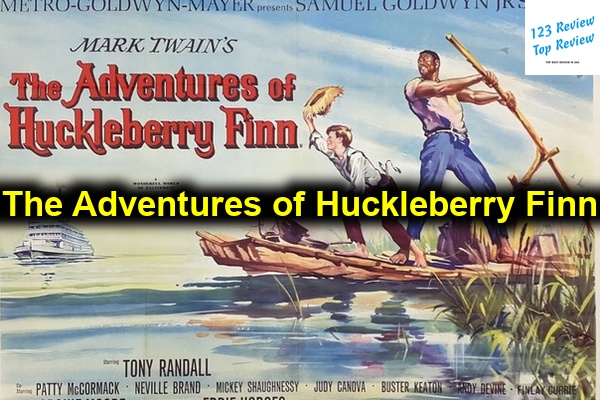Published in 1884, the novel continues to capture readers’ imaginations with its exploration of complex themes, vivid characters, and insightful social commentary. Following the adventures of a young boy named Huck Finn as he navigates the Mississippi River, the story presents profound reflections on freedom, morality, and the societal issues of Twain’s time.
In this detailed review, 123 Review will explore the key themes, character analyses, literary devices, historical context, and critical reception of this enduring classic.
Key Themes in The Adventures of Huckleberry Finn
Exploration of Freedom and Slavery
One of the central themes of The Adventures of Huckleberry Finn is the exploration of freedom and slavery. Twain intricately weaves the experiences of the protagonist, Huck Finn, and his companion, Jim, illustrating the complexities of freedom in a society that endorses slavery.

Huck’s journey down the Mississippi River symbolizes a quest for liberation. Fleeing from his abusive father and the constraints of civilization, Huck seeks independence and self-discovery. The river serves both as a literal pathway to freedom and a metaphorical representation of Huck’s desire to escape societal norms. Throughout this journey, he confronts the deeply ingrained racial prejudices of his society, particularly as he helps Jim, a runaway slave, seek freedom from bondage.
Jim’s character adds a poignant layer to this theme. As an enslaved man seeking his freedom, he represents the human cost of slavery and the yearning for dignity that transcends racial boundaries. Through his friendship and experiences shared with Huck, Twain prompts readers to consider the moral implications of slavery and the inherent struggles for autonomy in the face of systemic oppression.
The relationship between Huck and Jim ultimately challenges societal norms. Huck’s evolving understanding of friendship and loyalty leads him to prioritize his personal values over the societal expectations that dictate his behavior. This internal conflict illuminates the theme of moral choice, showcasing Huck’s realization that true freedom is not just about physical escape but also about ethical integrity and human connection.
Conflict Between Civilization and Nature
Another prominent theme in the novel is the conflict between civilization and nature. Twain contrasts the constraints of society—represented by the towns and families Huck encounters—with the unrestrained freedom of the natural world, as exemplified by the Mississippi River.
Huck’s experiences with civilization often highlight its hypocrisy and moral decay. From the oppressive rules of his abusive father to the constraints of societal expectations, Huck finds himself increasingly disillusioned with the constraints that society imposes. In contrast, life on the river symbolizes liberation and simplicity. The natural environment becomes a refuge for Huck and Jim, a space where they can forge their identities away from the prejudices and constraints of society.
Through this conflict, Twain critiques the societal norms prevailing in the antebellum South and suggests that a return to nature can lead to a more authentic existence. This duality reflects Huck’s internal struggle as he grapples with his feelings toward conformity and individualism. The natural world serves as a backdrop for Huck’s moral development, allowing him to confront the conventions of civilization and question the values instilled in him.
Moral Growth and Conscience
Moral growth and the development of conscience are at the heart of Huck Finn’s narrative. Twain intricately explores Huck’s journey as he grapples with questions of right and wrong amidst the conflicting values of his society. Huck’s evolving moral compass is significantly influenced by his relationship with Jim, which challenges the racist ideologies ingrained in him.
As Huck journeys with Jim on the river, he confronts societal condemnation of helping a runaway slave. This moral crisis becomes a pivotal point in his development. Huck’s eventual decision to assist Jim, declaring, “All right, then, I’ll go to hell,” signifies a profound moral choice. In choosing friendship over societal norms, Huck asserts his independence and prioritizes his conscience over the values imposed by society.
Twain’s portrayal of Huck’s internal struggles serves as a critique of the moral hypocrisy of the time. Through Huck’s reflections and decisions, readers witness the formation of an ethical framework that valuably prioritizes empathy and human connection. This moral evolution emphasizes the capacity for growth shaped by experiences, relationships, and critical thinking, encouraging readers to reflect on their values and the societal constructs surrounding them.
Character Analysis
Huckleberry Finn as Protagonist
Huck Finn stands as one of literature’s most iconic protagonists, characterized by his adventurous spirit, resilience, and moral complexity. As a young boy of around thirteen, Huck embodies the spirit of freedom and rebellion against societal constraints. His tumultuous upbringing—marked by an abusive father, neglect from the Widow Douglas, and societal expectations—fuels his desire to escape and seek autonomy.
Huck’s character is defined by his deep questioning of societal norms. At times brash and impulsive, his instincts guide him to challenge the prejudiced beliefs surrounding him. This innate sense of justice becomes apparent when he chooses to help Jim, leading him to confront the moral dilemmas inherent in slavery and racism. Huck represents the struggle for identity amidst external influences, embodying the timeless quest for understanding oneself in relation to society.
Throughout the narrative, Huck’s character development is marked by a transition from innocence to experience. He begins as a boy grappling with the constraints imposed by civilization and evolves into a thoughtful individual capable of moral reasoning. This growth is intricately woven into the fabric of the story, compelling readers to navigate alongside Huck as he wrestles with love, friendship, conscience, and humanity.
Jim: The Complex Representation of Slavery
Jim, the runaway slave, serves as a pivotal character through whom Twain explores the theme of slavery and human dignity. Initially introduced as a comedic character, Jim’s depth unfolds as he embodies the struggles and aspirations of enslaved individuals, challenging the stereotypes prevalent in the society of Twain’s time.
Jim’s desire for freedom is rooted in love, as he seeks to reunite with his family. His character represents the harsh realities faced by enslaved individuals while simultaneously highlighting their humanity, intelligence, and resilience. Twain portrays Jim as a caring figure—the moral center of the novel—often providing wisdom and guidance to Huck amid their trials.
Twain uses Jim’s relationship with Huck to challenge social norms. As their bond deepens, Huck begins to see Jim as an equal, recognizing his humanity despite societal conditioning. This shift in perception underscores the novel’s critique of racism and the moral failures of a society that dehumanizes people based on skin color. Jim’s character development prompts readers to reconsider preconceived notions about race and the humanity of individuals relegated to the margins of society.
Through Jim, Twain confronts both the physical and psychological chains of slavery. His character embodies the struggle for familial bonds, personhood, and dignity, amplifying the emotional resonance of the narrative. The relationship between Huck and Jim transcends the boundaries of friendship, serving as a profound commentary on the effects of slavery and the quest for freedom.
Tom Sawyer’s Role and Contrast to Huck
Tom Sawyer, Huck’s adventurous friend, serves as a foil to Huck’s character, highlighting the complexities of their differing perspectives on morality and adventure. While Tom represents the romantic ideals of adventure encapsulated in a world of childhood fantasies, Huck embodies pragmatism and realism.
Tom’s character is rooted in the societal norms of his upbringing; he often romanticizes not only adventure but also notions of heroism and chivalry. His tendency to embellish their adventures with tales of grandeur reflects the influence of societal expectations and the cultural narratives surrounding masculinity and heroism. In contrast, Huck’s raw and honest approach to challenges depicts a more authentic engagement with reality.
The contrast between Tom and Huck becomes particularly pronounced in their treatment of social issues, particularly slavery. While Tom adheres to the societal norms of his time, Huck’s moral compass leads him to challenge these very same norms. Tom’s adventurous plots often gloss over real human struggles, whereas Huck’s journey reveals the consequences of those struggles, inviting readers to engage in deeper ethical considerations.
Through their dynamic, Twain explores the idea of social conditioning and individual conscience. The tension between Huck’s straightforward morals and Tom’s fanciful ideals underscores the broader societal conflict regarding the realities of life versus romanticized notions of adventure. Tom’s character ultimately invites readers to question the validity of conformist ideals while emphasizing Huck’s journey toward a more genuine understanding of human experiences.
Literary Devices and Style
Use of Dialect and Regionalism
One of the hallmarks of The Adventures of Huckleberry Finn is Twain’s masterful use of dialect and regionalism. Twain employs authentic speech patterns, idioms, and dialects of the characters to capture the essence of life along the Mississippi River. This commitment to realism adds vividness and authenticity to the narrative, providing readers with a unique glimpse into the lives and cultures of the characters.
The use of dialect not only enriches character development but also immerses readers into the socio-economic and cultural contexts of the time. The distinctive voices of Huck, Jim, and other characters reflect their backgrounds and experiences, allowing readers to forge a deeper connection with their struggles and aspirations.
Furthermore, Twain’s incorporation of regionalism enhances the novel’s setting, portraying the specificities of life along the Mississippi River. The geographical landscape acts as a central character, influencing the experiences and relationships of the human characters. This focus on setting underscores the importance of place in shaping identities and narratives, contributing to the novel’s enduring influence in American literature.
Symbolism in the Mississippi River
The Mississippi River serves as a powerful symbol throughout The Adventures of Huckleberry Finn, representing both freedom and moral ambiguity. As the central axis of Huck and Jim’s journey, the river facilitates their quest for autonomy and serves as a refuge from the societal injustices they face.
On one hand, the river embodies freedom, providing a space for Huck and Jim to escape from the oppressive constraints of society. Their journey downriver symbolizes liberation—not only from physical enslavement for Jim but also from the societal expectations that confine Huck. The river becomes a site where they can redefine their identities and forge their paths, contrasting greatly with the rules and prejudices of life on land.
Conversely, the river also entails moral complexities. Though it offers an escape, it simultaneously exposes Huck and Jim to the dangers and turmoils of life. The challenges they encounter on their journey highlight the tensions between freedom and responsibility, illustrating that liberation does not come without its consequences. The river, thus, becomes a dual symbol—representing both the promise of freedom and the harsh realities that accompany it.
Narrative Technique and Point of View
Twain utilizes a first-person narrative perspective, allowing readers to experience the events of the story through Huck’s eyes. This choice not only deepens the connection between Huck and the reader but also highlights his unique voice, reflections, and struggles. The narrative’s informal style—infused with humor, colloquial language, and a distinctive perspective—captures the authenticity of Huck’s character.
Huck’s unreliable narration adds another layer of complexity to the story. As a young boy, Huck’s understanding of the world is shaped by his limited perspective, leading to moments of naivety and innocence. This unreliability invites readers to engage more critically with the narrative and encourages them to question the societal norms and values it portrays.
Twain’s narrative technique also emphasizes themes of moral ambiguity and the exploration of identity. Huck’s internal monologues provide insight into his struggles with conscience, illustrating the contradictions he faces as he navigates the social landscape of his time. Through this intimate storytelling, Twain crafts a compelling and relatable protagonist whose moral dilemmas challenge reader perceptions and prompt reflection on broader social issues.
Historical Context and Significance
Impact of the Reconstruction Era
The Adventures of Huckleberry Finn is deeply informed by the historical context of the Reconstruction Era following the Civil War, a pivotal period marked by attempts to grapple with the legacies of slavery, racial inequality, and societal change. The landscape of America during this era was rife with tensions surrounding race relations and the struggles of formerly enslaved individuals to claim their rights.
Twain’s depiction of the South and its racial dynamics reflects the societal realities of the time. The novel offers keen observations on the lingering attitudes toward race and slavery even after the Emancipation Proclamation. The interactions between Huck and Jim provide a platform through which Twain critiques the systemic racism prevalent in society and examines the broader implications of freedom.
By setting Huck and Jim’s journey against the backdrop of the Reconstruction Era, Twain emphasizes the moral complexities surrounding race, love, and friendship. The novel serves as both a critique and an exploration of a nation seeking to redefine itself in the aftermath of conflict, pinning hope on the potential for reconciliation and understanding amidst adversity.
Reflection of Societal Issues in America
The Adventures of Huckleberry Finn stands as a profound commentary on the societal issues plaguing America, particularly concerning race, class, and moral integrity. Twain’s narrative exposes the hypocrisy and injustices inherent in a society that simultaneously professes values of liberty and equality while perpetuating systems of oppression.
The novel portrays instances of blatant racism and discrimination, challenging readers to confront the uncomfortable realities of social injustice. Twain’s utilization of humor and satire critiques the absurdities of racism and the irrationality of societal norms, prompting deeper reflection on the moral implications of such beliefs.
Moreover, the novel delves into class distinctions, contrasting the lives of the wealthy with those of the impoverished. Through characters like the Duke and the King—two con artists who exploit others—Twain reveals the darker aspects of human nature and the exploitation embedded within societal hierarchies.
This exploration of societal issues invites readers to engage critically with their own moral compasses, prompting reflections on justice, freedom, and human rights. The novel’s commentary on the societal fabric of America remains relevant today, as readers grapple with ongoing challenges surrounding inequality and discrimination.
Mark Twain’s Perspective on Race and Morality
Twain’s perspective on race and morality is multifaceted, shaping both the characters and themes within The Adventures of Huckleberry Finn. Through Huck’s evolving conscience and his relationship with Jim, Twain addresses longstanding racial prejudices while advocating for a deeper understanding of humanity.
While the novel operates within the context of its time—replete with the language and attitudes of 19th-century America—it also serves as a catalyst for challenging these attitudes. Twain’s portrayal of a sympathetic and relatable Jim invites readers to sympathize with his plight, positioning the narrative as a critique of the institution of slavery ingrained in American society.
Moreover, Twain implores readers to confront their own biases. As Huck wrestles with the societal condemnation of helping a runaway slave and ultimately decides to prioritize his evolving moral convictions over convention, the narrative compels readers to engage in introspection about their beliefs and values.
Through this nuanced exploration of race and morality, Twain crafts a narrative that not only reflects the prejudices of its time but also serves as a call to consciousness. The novel becomes an instrument for examining and challenging social norms, urging readers to reconsider their approaches to issues of race, equity, and justice.
Reception and Criticism
Initial Controversy and Censorship
Upon its publication, The Adventures of Huckleberry Finn ignited controversy due to its candid exploration of race, language, and societal critiques. Critics and audiences alike were divided, with some hailing it as a monumental work while others decried it for its perceived vulgarity and moral implications.
The use of racial slurs and the portrayal of Jim as a complex character sparked debate over the legitimacy of Twain’s motivations and the potential harm of the language employed. Unsurprisingly, many institutions sought to censor or ban the book, viewing it as inappropriate for young readers. This censorship echoed broader societal tensions regarding race relations and the legacy of slavery.
Despite the objections, the novel garnered significant praise from literary critics who recognized its depth, humor, and social commentary. They acknowledged Twain’s ability to address sensitive topics in a manner that forced readers to confront uncomfortable truths about their society.
Modern Interpretations and Adaptations
In contemporary discussions, The Adventures of Huckleberry Finn continues to resonate, prompting varied interpretations and adaptations that reflect a changing societal landscape. Modern readers navigate the complexities of race, morality, and identity within the narrative, viewing it through different lenses that reflect overarching conversations around equity and justice.
Some modern interpretations focus on the significance of Huck’s moral journey and his relationship with Jim, underscoring themes of friendship and humanity that transcend racial divides. As discussions surrounding race and representation continue to evolve, the novel remains a subject of analysis that enables meaningful dialogue about the past and its implications for the present.
Adaptations of the novel—from stage productions to films—also reflect contemporary sensibilities. Reimaginings often recast the characters or adjust language to align with modern values. These interpretations serve to keep Twain’s work alive while addressing the criticisms that have emerged over time.
Influence on American Literature
The impact of The Adventures of Huckleberry Finn on American literature cannot be overstated. Often hailed as one of the first modern American novels, Twain’s work opened the literary landscape to explore complex characters, moral dilemmas, and the social landscape of America.
Hemingway famously declared that “all modern American literature comes from one book by Mark Twain called Huckleberry Finn“. The novel’s unique narrative style, profound themes, and portrayal of regionalism significantly shaped the paths of subsequent authors. Writers such as F. Scott Fitzgerald, William Faulkner, and contemporary novelists have drawn inspiration from Twain’s exploration of social issues, character development, and narrative voice.
Furthermore, the critical discussions ignited by the novel set the stage for ongoing conversations surrounding race, identity, and morality in literature. By addressing uncomfortable truths and challenging societal norms, Twain’s work paved the way for future authors to tackle similarly complex themes.
Conclusion on the Legacy of The Adventures of Huckleberry Finn
Lasting Impact on Readers
The Adventures of Huckleberry Finn endures as a significant work in American literature, leaving a lasting impact on readers and shaping their understanding of freedom, morality, and the complexities of human relationships. Twain’s exploration of themes surrounding race, identity, and the struggle for autonomy continues to resonate, encouraging critical reflection on contemporary societal issues.
Huck’s journey remains a compelling narrative that appeals to the imagination while prompting readers to confront their values and biases in relation to issues of race and justice. The profound moral dilemmas presented not only reveal the complexities of human experience but also illustrate the importance of empathy, understanding, and connection in navigating the challenges of society.
Importance in Literary Canon
As a cornerstone of the American literary canon, The Adventures of Huckleberry Finn retains its place as a powerful commentary on the injustices of its time. Twain’s ability to depict the intricacies of society through the eyes of a young boy grappling with moral choices has solidified the novel’s status as a timeless work.
The novel’s examination of societal constructs, its challenges to racial prejudices, and its exploration of personal liberties continue to speak to readers across generations. Its unflinching portrayal of difficult themes allows for meaningful engagement with history, urging readers to reflect on the lessons contained within its pages.
In conclusion, Mark Twain’s The Adventures of Huckleberry Finn stands as a monumental achievement in literature—a profound exploration of freedom, friendship, and the moral dilemmas that shape the human experience. Through Huck’s journey and the rich tapestry of characters and themes, Twain invites readers to embark on an enduring journey of discovery and self-reflection, making Huckleberry Finn a literary landmark that continues to inspire and challenge readers today.





